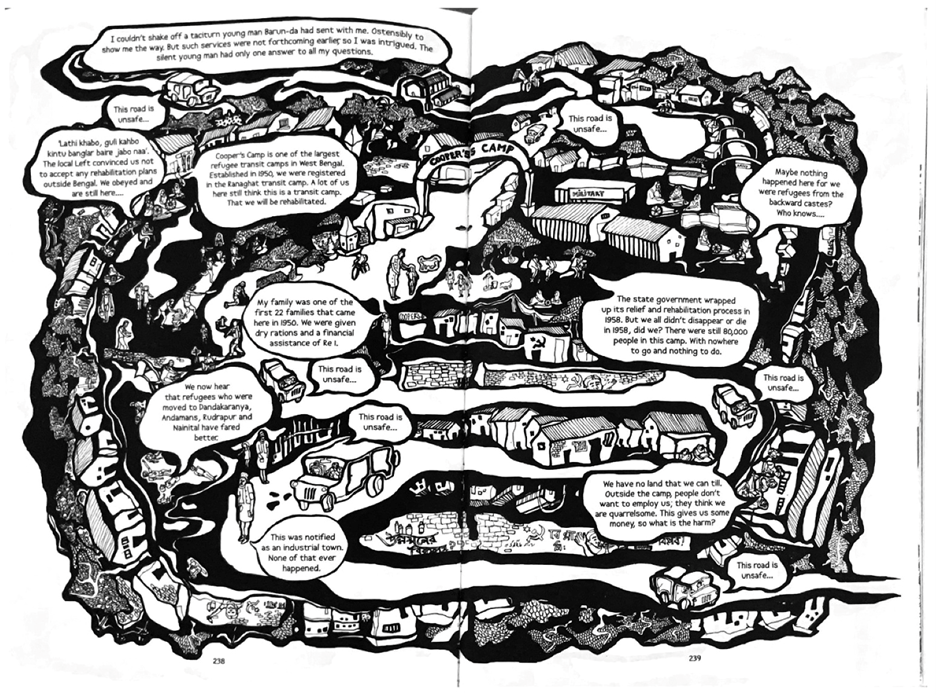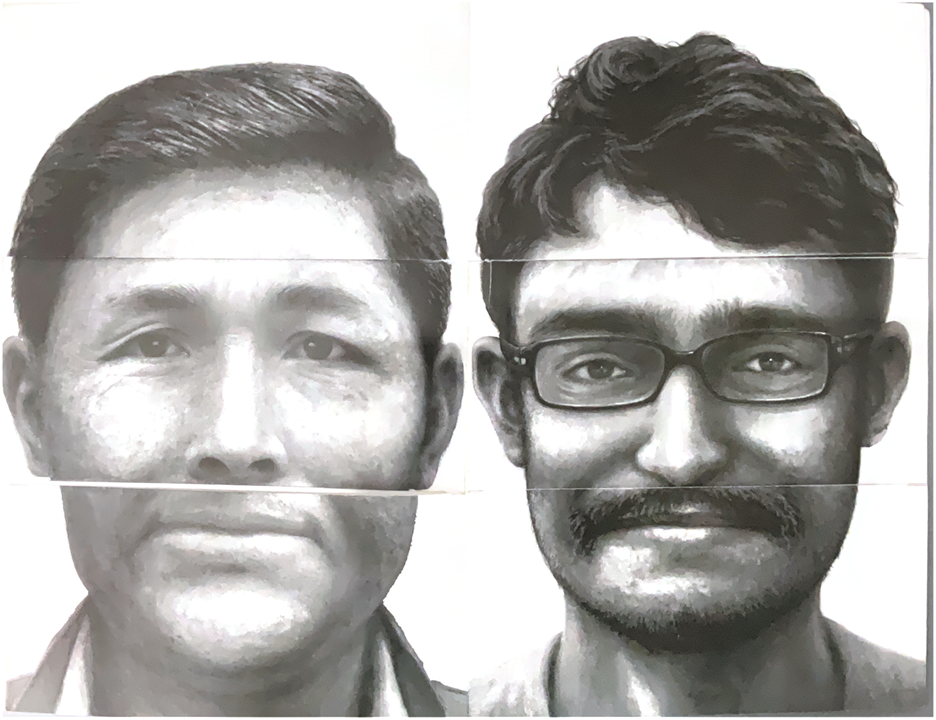Research on Real-Time Detection and Classification of Defects in PCBAs
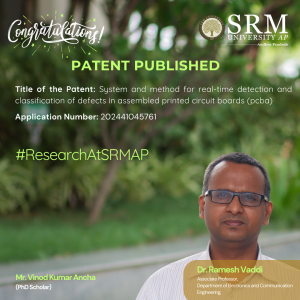 In today’s fast-paced technological world, ensuring the quality and reliability of electronic devices is essential. Associate Professor Dr Ramesh Vaddi and his research Scholar Mr Vinod Kumar Ancha from the Department of Electrical and Electronics Engineering introduce an innovative system for real-time detection and classification of defects in PCBAs, leveraging advanced machine learning techniques. Their research titled, “System And Method For Real-Time Detection And Classification of Defects in Assembled Printed Circuit Boards (PCBA)” was published in the Patent Journal with Application number 202441045761.
In today’s fast-paced technological world, ensuring the quality and reliability of electronic devices is essential. Associate Professor Dr Ramesh Vaddi and his research Scholar Mr Vinod Kumar Ancha from the Department of Electrical and Electronics Engineering introduce an innovative system for real-time detection and classification of defects in PCBAs, leveraging advanced machine learning techniques. Their research titled, “System And Method For Real-Time Detection And Classification of Defects in Assembled Printed Circuit Boards (PCBA)” was published in the Patent Journal with Application number 202441045761.
Abstract:
This study presents a new system for real-time detection and classification of defects in Assembled Printed Circuit Boards (PCBAs), which are critical in electronic products and systems. It employs an efficient model with pretrained weights to detect defects for enhanced quality control. The model is initially trained and fine-tuned on a computer, then deployed on a compact computing board. For real-time imaging, a high-definition USB camera is connected to the system, allowing direct defect identification without the need for external devices. The output is shown on a monitor, with the PCBA image featuring clearly labeled boxes to indicate the type and location of defects. This method offers a streamlined approach to defect classification, helping to improve the quality control process in electronics manufacturing.
Explanation of the Research in layperson’s terms:
This research focuses on finding defects or flaws in Assembled Printed Circuit Boards (PCBAs). Which are the “backbone” of most electronic devices, like computers and phones. This system uses a powerful computer model to “look” at these boards and quickly identify any defects, like missing holes, mouse byte, open circuit, short circuit, spur and spurious copper in real-time. The research starts by training this model using a deep learning object detection model on a regular computer, teaching it to recognize what a normal PCBA looks like and what various defects might look like. Once it’s ready, we transfer the model to a small, efficient computer edge board, which does all the processing. A camera is used to capture images of the PCBAs, and the system analyzes these images to find respective defects. The results are displayed on a screen, where it clearly marks where the defects are and what kind of defects they are. Overall, this system helps companies detect defects in their electronics manufacturing process quickly and accurately, which can save time, reduce waste, and improve the quality of their products.
Practical Implementation:
The practical implementation of our research involves deploying a system for real-time detection and classification of defects in Assembled Printed Circuit Boards (PCBAs) a crucial component in nearly all electronic devices. By using advanced Deep learning techniques, our system can quickly identify manufacturing defects, allowing electronics manufacturers to detect the defect early in the production process. This can lead to significant improvements in quality control, reduced waste, and lower production costs. By improving quality control in electronics manufacturing, the system can help reduce electronic waste, which is a significant environmental concern. Early detection of defects also reduces the chances of faulty electronic products reaching consumers, thereby improving safety and reducing the need for product recalls. Additionally, the efficiency and accuracy of our system could lead to more reliable electronics, contributing to greater consumer trust in electronic products. This, in turn, could encourage companies to invest in higher-quality manufacturing processes, ultimately leading to a more sustainable and responsible electronics industry.
Collaborations:
To develop our system, we first trained a computer model to recognize defects in Assembled Printed Circuit Boards (PCBAs). This training process involved feeding the model a large dataset of PCBA images, some with defects and some without. By analyzing these examples, the model learned to identify common defects, like Missing hole, mouse byte, open circuit, short circuit, Spur and Spurious copper. Once the model was trained, we implemented it in a real-time setting. This meant integrating it with equipment that could inspect PCBAs as they were being produced. The system used a camera to capture images of each PCBA and then applied the trained model to analyze those images, checking for any defects. With the model running in real-time, the system could immediately detect issues and alert the manufacturing team, allowing them to correct problems on the spot. This approach helped improve the quality of the final product and reduced the chances of defective electronics reaching consumers. It also sped up the quality control process and reduced waste, making the entire manufacturing process more efficient.
Future Research Plans:
Our future research plans focus on enhancing and expanding our system for defect detection in Assembled Printed Circuit Boards (PCBAs):
Model Optimization: We aim to further refine our machine learning model to improve accuracy and speed. This includes experimenting with different architectures and training techniques to boost performance.
Expanded Defect Library: We plan to gather a more extensive dataset of PCBA defects, allowing our model to identify a wider range of issues. This will make the system more versatile and capable of handling various manufacturing environments.
Real-World Testing: We intend to test our system in a broader range of manufacturing settings to ensure its robustness and adaptability. This will help us understand how it performs in diverse real-world scenarios and how we can fine-tune it for optimal results.
Integration with Manufacturing Systems: Our goal is to integrate our system with other manufacturing processes and technologies. This will allow for seamless communication between defect detection and other quality control systems, enhancing the overall manufacturing workflow.
Automation and Robotics: We’re interested in exploring the use of automation and robotics to streamline the defect detection process. This could lead to a more automated manufacturing line, reducing human intervention and potential errors.
Collaboration and Partnerships: We plan to collaborate with more industry partners and academic institutions to accelerate our research and development. These partnerships will provide valuable insights and resources for advancing our system.
- Published in Departmental News, ECE NEWS, News, Research News
Advancing Next-Gen Networks with MIMO Channel Capacity at 300 GHz
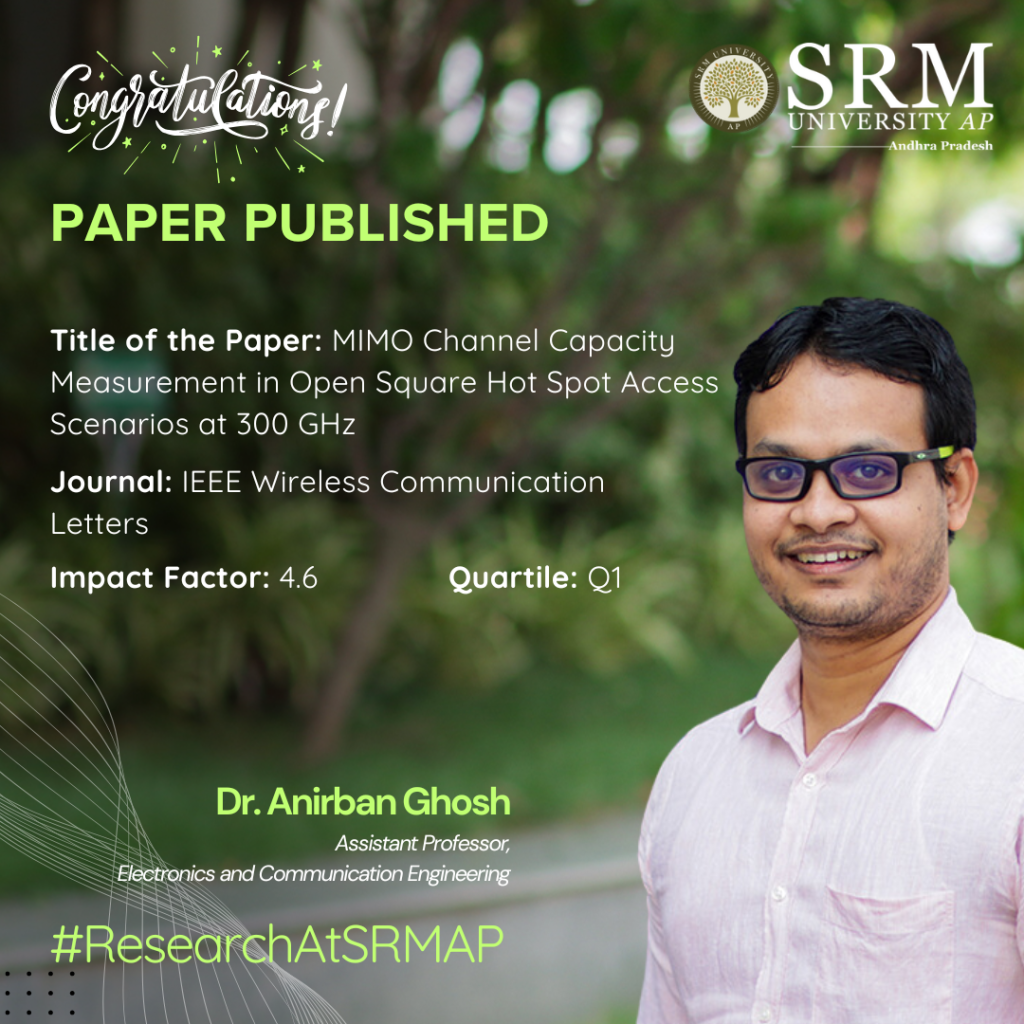
The Department of Electronics and Communication Engineering is pleased to announce the publication of a significant research paper by Dr Anirbhan Ghosh, Assistant Professor, exploring MIMO channel capacity at high frequencies (300 GHz), which holds great potential for beyond 5G and 6G networks. The paper “MIMO Channel Capacity Measurement in Open Square Hot Spot Access Scenarios at 300 GHz” published in the Q1 journal IEEE Wireless Communication Letters, investigates data transmission in three different line-of-sight (LoS) scenarios and contributes to building the next generation of communication networks, which will have a significant positive impact on society by improving connectivity, supporting technological advancements, and promoting economic development.
Abstract
This letter explores the possibility and effectiveness of using multiple communication paths for futuristic outdoor networks, focusing on three scenarios: clear line-of-sight (LoS), partially obstructed line-of-sight (OLoS), and completely blocked line-of-sight (NLoS). A study was conducted at a high frequency of 300 GHz to measure how many useful communication paths are available for transmitting data simultaneously. Based on the results, the average data transmission capacity for these paths was calculated, both with and without the help of passive reflecting surfaces (PRS). The findings show that using multiple antennas significantly boosts the average data capacity, and PRS further enhances this improvement.
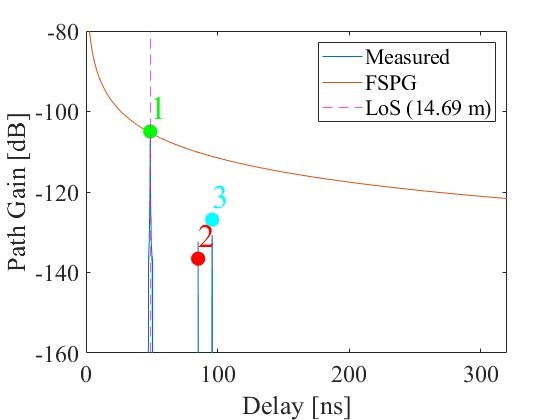
Practical Implementation of the Research
The results align with the design of high-frequency, ultra-high-speed, low-latency, reliable communication envisioned for several futuristic applications beyond 5G and 6G Networks.
Collaborations
Prof. Minseok Kim, Professor, Faculty of Engineering, Course of Electrical and Electronics Engineering, Niigata University, Japan.
Dr Ghosh plans to extend his efforts to other communication scenarios for a similar study. He opines that generating appropriate channel models, coverage design, etc., for the explored scenario would also be an exciting study.
- Published in Departmental News, ECE NEWS, News, Research News
Dr Rangabhasiyam on Tackling the Issue of Microplastic Pollution
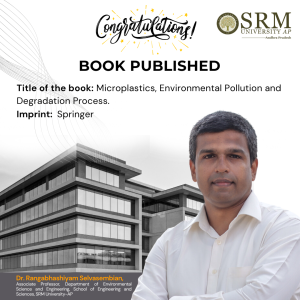 Microplastic pollution is an urgent environmental crisis that threatens ecosystems on land and in water. Addressing this critical issue, Associate Professor and HoD, Dr Rangabhashiyam Selvasembian from the Department of Environmental Science and Engineering has published a groundbreaking book titled Microplastics, Environmental Pollution and Degradation Process with Springer. This book examines the perilous effects of microplastics, their characterisation, and innovative treatment strategies. By integrating the latest research and insights, Dr Selvasembiyan’s work serves as a vital guide for students, researchers, and policymakers committed to combating microplastics and protecting our environment.
Microplastic pollution is an urgent environmental crisis that threatens ecosystems on land and in water. Addressing this critical issue, Associate Professor and HoD, Dr Rangabhashiyam Selvasembian from the Department of Environmental Science and Engineering has published a groundbreaking book titled Microplastics, Environmental Pollution and Degradation Process with Springer. This book examines the perilous effects of microplastics, their characterisation, and innovative treatment strategies. By integrating the latest research and insights, Dr Selvasembiyan’s work serves as a vital guide for students, researchers, and policymakers committed to combating microplastics and protecting our environment.
About this Book
This book presents microplastics pollution in land and water bodies, their hazardous effects, characterization approaches, and suitable means of utilizing advanced treatment options to solve the problem. It is mainly understood that microplastic pollutants are associated with water bodies, however there also exists soil contamination and their interaction with the food web. The discussions related to strategies and policies for the management of microplastics are very limited. This book not only narrows microplastic pollution in marine or fresh water bodies, but also takes into account the terrestrial environment, including the toxicity effects, characterization aspects and treatment approaches. The main feature of the book includes latest research related to microplastics pollution, examining the different health effects including environmental (related) issues and highlights the advances in treatment approaches. The book serves as a guide with an up-to-date information on microplastics related problems useful for students, researchers, professionals/environmentalists and also as a reference for policy makers.
Collaborations:
- Professor Ajay Kumar Mishra, Professor – Durban University of Technology, South Africa.
- Dr. Pankaj Raizada, Professor -School of Advanced Chemical Sciences, Shoolini University, Solan (H.P) India.
- Dr Elsayed T Helmy, Researcher – National Institute of Oceanography and Fisheries, Egypt
- Prof. Santhiagu Arockiasamy Professor- National Institute of Technology Calicut, India.
Link to the article: https://doi.org/10.1007/978-981-97-6461-7
- Published in Departmental News, ENVS News, News, Research News
Tracing Feminist Discourse in the Intellectual Output of Women Trade Unionists in Late Colonial Bengal
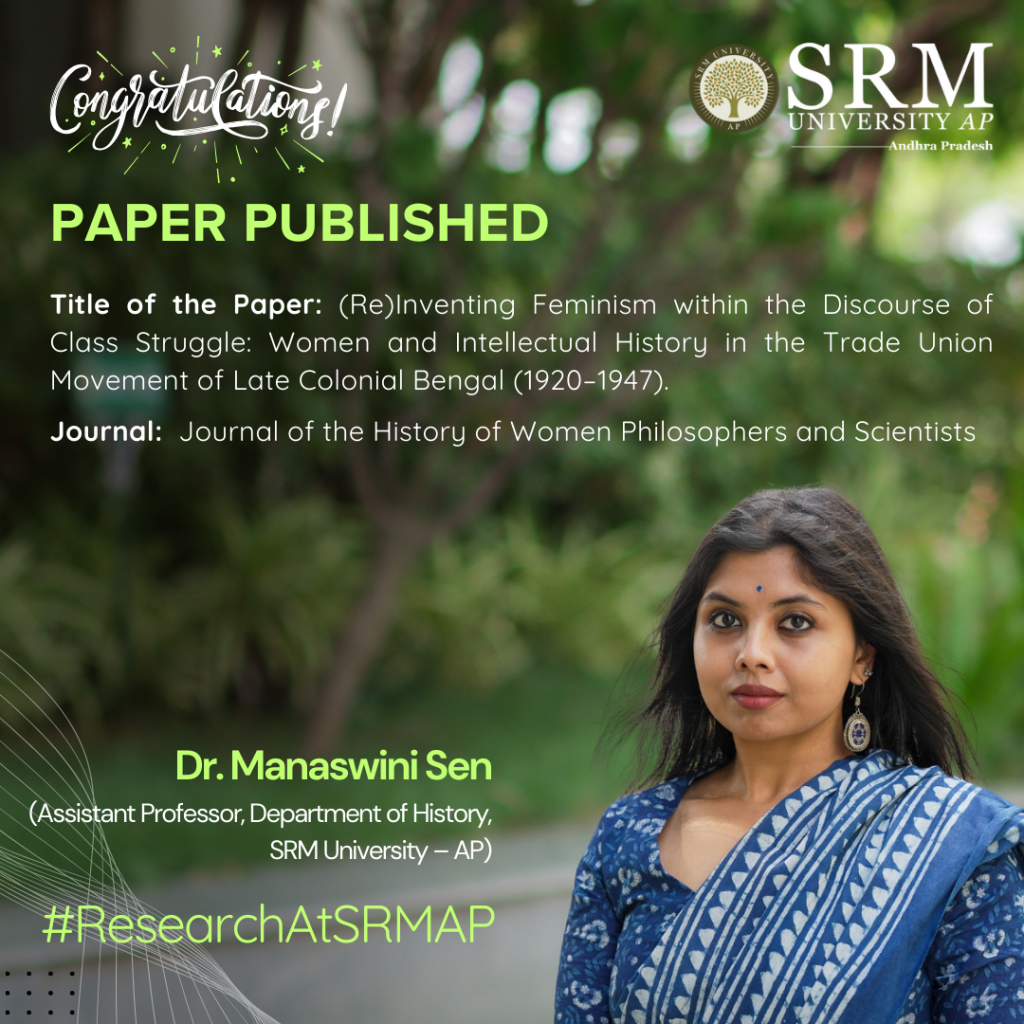
Dr Manaswini Sen, Assistant Professor at the Department of History, has published an insightful paper tracing the ideological and intellectual output of women trade unionists in late colonial Bengal. Her research paper titled “(Re)Inventing Feminism within the Discourse of Class Struggle: Women and Intellectual History in the Trade Union Movement of Late Colonial Bengal (1920–1947)”, published in the prestigious Journal of the History of Women Philosophers and Scientists, offers a novel perspective on understanding the class struggle, anticolonial discourse in the patriarchal society of colonial Bengal.
Abstract
This paper envisages (re)constructing the intellectual praxis of women trade unionists in late colonial Bengal. By arguing how political practice habitually translates to political thought, the paper devises a methodology to address the gendered discourse of intellectual history in the Global South. It focuses on intellectual output, primarily journal articles of women trade unionists like Santoshi Kumari Gupta, Maitreyee Bose, and Kanak Mukherjee, to trace a genealogy of how class struggle was perceived by women labour activists across the ideological spectrum of nationalism, socialism, and communism between 1920 to 1947 in Bengal. The piece is an effort to transcend the manifold marginalisations that plague the establishment of feminine political praxis within the regulating structures of colonialism and capitalism. In the process, it bids to unfold an alternative narrative of the anti-colonial, anti-capitalist, and anti-patriarchal narrative of the decolonisation of South Asian intellectual thought.
Research, Collaboration and Future Research Plans
The research strives to bring to the forefront the intellectual contributions of three female trade unionists in the late colonial period to trace the evolution of discourses on anticolonial class struggle from a gendered perspective. With the global turn in intellectual history, there is an augmented effort at amplifying the ‘small voices of history’. The inherent socio-cultural predicaments in our society make it inordinately challenging to trace conventional sources for mapping the intellectual endeavours of women. This paper aims to rectify this gap by reconstructing women labour activists’ intellectual practises and literary output in the early 20th century. In the process, the research tries to bring forth narratives of anticolonialism, which drowns in the overwhelming presence of nationalism in the discourses of decolonisation of South Asia. This paper was the result of academic exchanges with professors of Benaras Hindu University, Dr B.R. Ambedkar University, Delhi, and the University of Paderborn, Germany.
Dr Sen primarily researches marginal anticolonial epistemological traditions of South and South East Asia. Her thesis on the evolution and dissemination of socialism in late colonial Bengal, which focuses on an intellectual history of trade unionism, forms the basis of her first monograph. However, she is now focusing on the transnational and transcontinental intellectual networks of a wide spectrum of leftist labour activists and proto-nationalists and the ways these fringe intellectual traditions interacted with each other and nationalism. Based on a rich archive across India and Europe and a plethora of alternative sources, she tends to devise new methodological interventions in the field of Global Intellectual History, making labour history more accessible and relevant in scholarly circles.
- Published in Departmental News, History Current Happenings, History News, News, Research News
Decolonial Insights on Partition in Indian Comics
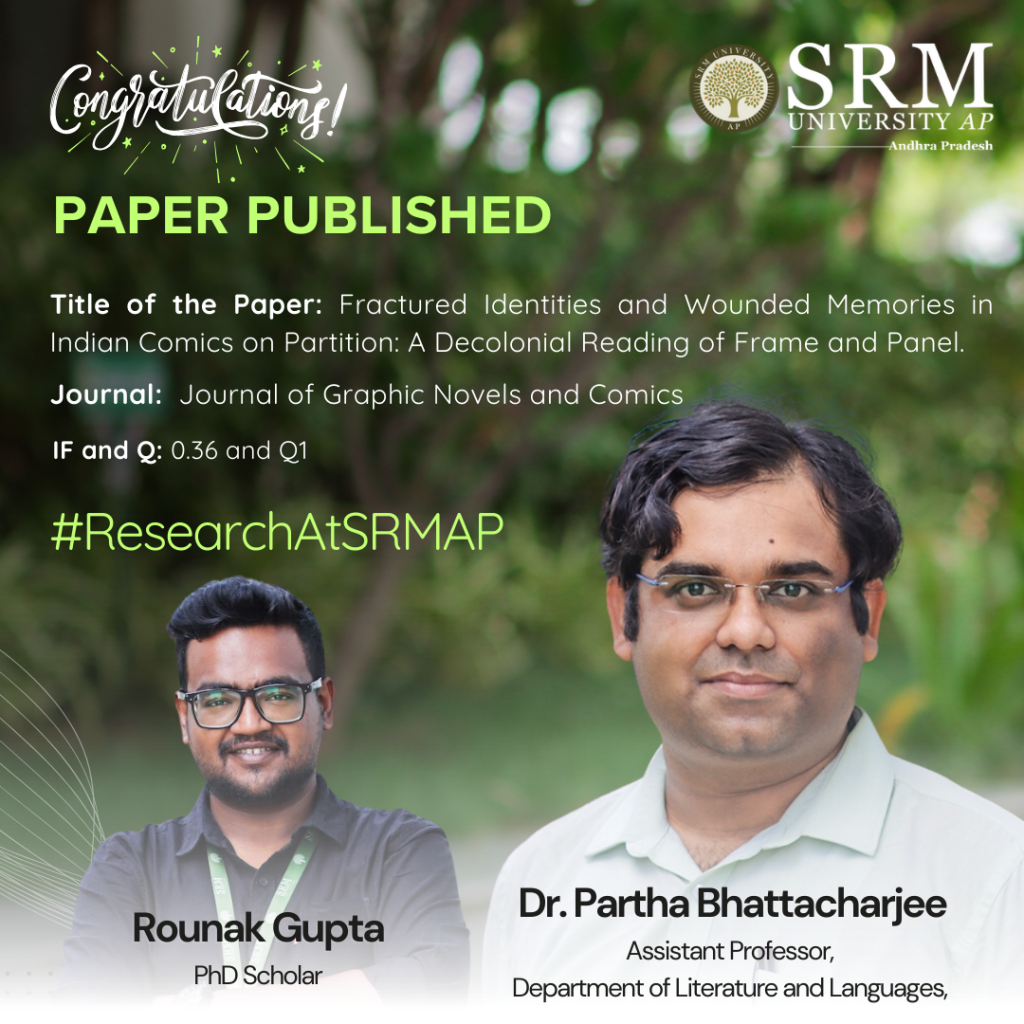
Dr Partha Bhattacharjee, Assistant Professor from the Department of Literature and Languages, along with his scholar Mr Rounak Gupta has published their paper titled “Fractured Identities and Wounded Memories in Indian Comics on Partition: A Decolonial Reading of Frame and Panel” in the esteemed Q1 journal Journal of Graphic Novels and Comics. This paper explains comics as a medium whose panels, frames, and stylistic aspects can be interpreted in the Indian context. This interpretation has been read as a decolonial intervention into the medium’s history and the established aesthetic theories.
Abstract
Within the liaison of decoloniality studies and comics studies, this paper investigates how the decolonial visual style in the comics anthology This Side That Side (2013) has been used to locate the traumatised past and violation of human rights due to the “b/ordering” practices of partition of India (Rifkind 2017; Bhattacharjee and Tripathi 2022). “The Taboo” by Malini Gupta and Dyuti Mittal, “An Afterlife” by Sanjoy Chakraborty, and “Making Faces” by Orijit Sen cultivate the stories of the inhumane condition of the migrants and victims during and after the Indo-Pakistan and Indo-Bangladesh-Pakistan partition. These narratives exemplify decolonised counter comics narratives on collective and personal memories (Chute 2016; Mickwitz 2016; Ahmed and Crucifix 2018) inflicted upon and against the dominant partition discourse. They help churn out the human stories of the interminable psychological violence of partition and post-partitioned reality.
The paradigm established in this research can later be used to interpret different formations within comics, especially pertaining to decolonial aesthetics, dialogue, and attitude.
Collaborations
This paper has been published as a part of a continuing study that began with the preceding paper – Bhattacharjee, Partha, and Priyanka Tripathi. 2022. “Penning the Pain of Partition: Refugee Camp Narratives in Indian Comics.” Studies in Comics 12(2): 179-200. DOI: https://doi.org/10.1386/stic_00062_1.
- Published in Departmental News, English Current Happenings, English news, News, Research News
Insights on (Re)Framing Identity by Dr Stella
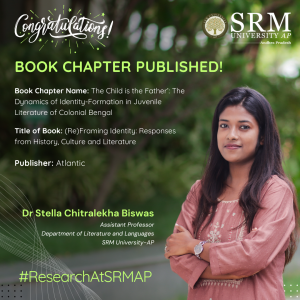 The complexities of identity in literature are a significant area of scholarly inquiry, especially in colonial and postcolonial studies. A key addition to this discourse is Assistant Professor, Dr Stella Chitralekha Biswas’ book chapter on “The Child is the Father: The Dynamics of Identity-Formation in Juvenile Literature.” in the anthology, (Re)Framing Identity: Responses from History, Culture and Literature by Atlantic Publishers & Distributors.
The complexities of identity in literature are a significant area of scholarly inquiry, especially in colonial and postcolonial studies. A key addition to this discourse is Assistant Professor, Dr Stella Chitralekha Biswas’ book chapter on “The Child is the Father: The Dynamics of Identity-Formation in Juvenile Literature.” in the anthology, (Re)Framing Identity: Responses from History, Culture and Literature by Atlantic Publishers & Distributors.
A Brief Introduction to the Book:
This anthology (Re)Framing Identity: Responses from History, Culture and Literature is a significant and timely effort to understand the issues of identity because in the postmodern age, it is one of the highly debated and discussed issues in the field of History, Culture and Literature. In the postmodern age, the question of identity with reference to literature becomes important because the monolithic idea of identity is challenged in both imaginative and critical works. The significance of this anthology also lies in the fact that it scrutinizes the process of identity formation in the Indian subcontinent and problematizes the notions of its unity and continuity across time and space philosophers. This anthology continues the tradition of the critique of identity formation right from Stuart Hall, who, in his article in Questions of Cultural Identity (1996) says, “The deconstruction has been conducted within a variety of disciplinary areas, all of them, in one way or another critical of the notion of an integral, originary and unified identity”. Therefore the purported aim of this anthology is to analyse the conflicts and amalgamation among numerous races, ethnic groups, religions, linguistic acommunities and various other stakeholders and to understand how these conflicts and amalgamations resulted in the formation of diversified identities in the light of Stuart Hall’s ideas, “identities are never unified and, in late modern times, increasingly fragmented and fractured; never singular but multiply constructed across different, often intersecting and antagonistic, discourses, practices and positions. They are subject to a radical historicization, and are constantly in the process of change and transformation”
Significance of the Book Chapter:
The understanding of identity formation has evolved from the philosophical understanding to its discursive formation and further to the neurological understanding of how identity is shaped. The fundamental idea followed in the anthology can be summed in by Stuart Hall, “actually identities are about questions of using the resources of history, language and culture in the process of becoming rather than being: not ‘who we are’ or ‘where we came from’, so much as what we might become, how we have been represented and how that bears on how we might represent ourselves. Identities are therefore constituted within, not outside representation. They relate to the invention of tradition as much as to tradition itself, which they oblige us to read not as an endless reiteration but as ‘the changing same’ not the so-called return to roots but a coming-to-terms-with our ‘routes’. They arise from the narrativization of the self, but the necessarily fictional nature of this process in no way undermines its discursive, material or political effectivity, even if the belongingness, the ‘suturing into the story’ through which identities arise is, partly, in the imaginary (as well as the symbolic) and therefore, always, partly constructed in fantasy, or at least within a fantasmatic field”. This particular analysis of identity formation in the Indian subcontinent under numerous pressures exerted through various mediums like literature, folk theatre and literature and philosophical texts not only in India but outside as well among the Indian diaspora located especially in Euro-American parts of the world, making this anthology a crucial book not only in the country but also at an international level.
Target Audience:
It is inspiriting to read such exhaustive literary anthology by eminent academicians and scholars and broadens one’s horizon of critical thinking as one goes through the collection. The book will definitely open up new trajectories of research in the field of postcolonial studies, bhasha literature and identity theory. It will also motivate students and researchers to explore the formation and representation of identities in the subcontinent in terms of culture, race, ethnicity, language, religion, caste, gender and politics.
- Published in Departmental News, English news, News, Research News
Advancements in Optical Technologies: Paper by Dr Devdutt Tripathi
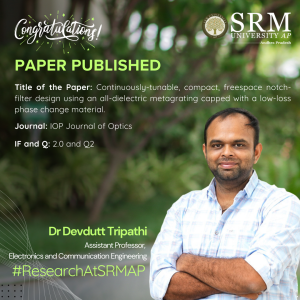 This research paper titled, “Continuously-tunable, compact, freespace notch-filter design using an all-dielectric metagrating capped with a low-loss phase change material” by Dr Devdutt Tripathi, Assistant Professor, Department Electronics and Communication Engineering explores the use of active metasurfaces combined with phase change materials (PCMs) to enhance optical technologies thereby enhancing optical technologies across various sectors including telecommunications and imaging sectors.
This research paper titled, “Continuously-tunable, compact, freespace notch-filter design using an all-dielectric metagrating capped with a low-loss phase change material” by Dr Devdutt Tripathi, Assistant Professor, Department Electronics and Communication Engineering explores the use of active metasurfaces combined with phase change materials (PCMs) to enhance optical technologies thereby enhancing optical technologies across various sectors including telecommunications and imaging sectors.
Abstract:
Active metasurfaces utilising phase change materials (PCMs) are currently under investigation for applications in free-space optical communication, optical signal processing, neuromorphic photonics, quantum photonics, and compact LiDAR. Attention has now turned towards novel PCM like Sb2S3 which exhibit lower optical absorption and reasonable values of refractive-index contrast in comparison to traditional data-storage PCM. We propose and numerically study the class of all-dielectric metagratings capped with low-loss PCM and predict the possibility of continuously tunable resonances whose quality factors degrade gracefully during the amorphous-to-crystalline phase transition of the PCM. Specifically, we consider the CMOS-compatible silicon-nitride on silica substrate material platform for simple and asymmetric metagratings (in particular, the symmetric-broken dimerization) and Sb2S3 capping. Our numerical study predicts that notch-filters operating around the 1550 nm NIR wavelength window can be achieved with tuning range of over 76 nm with Q-factors ranging from 784 (amorphous-phase) to 510 (crystalline-phase) (a degradation in Q of about 35%) and insertion loss of about 0.9 dB. These performance figures are a significant improvement over previously published designs utilizing data-storage PCMs and other traditional notch-filter mechanisms. We examine the influence of grating dimerization and geometrical parameters on performance metrics of the notch-filter and predict the possibility to trade-off rejection-band and in-band spectral transmission properties. Lastly, we perform a study of an all-optical phase change mechanism. Our study is promising for the miniaturization of tunable notch-filter based optical systems.
Explanation in Layperson’s Terms:
This research explores the use of advanced materials called metasurfaces (engineered materials especially in a 2D thin film structure), combined with phase change materials (PCMs- Semiconducting alloys of the Chalcogen family), for improving already existing and emergent technologies such as Optical communication, LiDAR (an acronym for Light Detection and Ranging), and Quantum photonics. Metasurfaces are thin layers with typical thickness ranging from a few hundred nanometers to several micrometers that can manipulate light in unique ways. In this study, the focus is on a specific PCM, Antimony Trisulphide (Sb2S3), which exhibits lower light absorption and better control over how it interacts with the incident light compared to traditional PCMs such as GST225 (Germanium Antimony Telluride) used in data storage. We propose a new design of metasurfaces, called metagratings, that can be “tuned” by changing the state of the PCM between amorphous and crystalline forms. The study predicts that these metasurfaces can be used to create notch filters, which block specific wavelengths of light, particularly around the 1550 nm range commonly used in fiber optics. When the PCM switches states, the filter can shift by 76 nm, with only a minor decrease in performance, about 35%. The study also looks at how small changes in the shape and structure of the metagratings can fine-tune their performance, allowing for a balance between filtering strength and light transmission. Overall, this research points to a promising way of miniaturizing and improving tunable optical filters for a range of high-tech applications.
Practical Implications:
This research has several practical implications:
1. Optical Communication: It can improve free-space optical
communication by offering tunable filters to enhance signal clarity and reduce interference.
2. Miniaturized LiDAR: Smaller, more efficient LiDAR systems for autonomous vehicles and 3D mapping can be developed.
3. Optical Signal Processing: Faster, more efficient photonic circuits could be created for data processing and telecommunications.
4. Neuromorphic and Quantum Photonics: The tunable metasurfaces can support advanced computing and quantum technologies by precisely controlling light.
5. Energy Efficiency: Sb₂S₃ uses less power than traditional materials, making devices more energy-efficient.
6. Sensing and Imaging: It can improve sensors and imaging systems by allowing more precise wavelength control.
7. CMOS Compatibility: The research can be integrated into existing semiconductor technologies, facilitating mass production.
Collaborators:
1. Prof. Hardik S. Vyas: Assistant Professor in Department of ICT, PDEU, Gandhinagar, Gujarat.
2. Prof. Ravi S Hegde, Associate Professor in Department of Electrical Engineering, IIT Gandhinagar, Gujarat.
Future Research Plans:
Research in Metasurface can be explored towards various applications such as imaging, microscopy as well as communication.
Article Link:https://iopscience.iop.org/article/10.1088/2040-8986/ad80a6
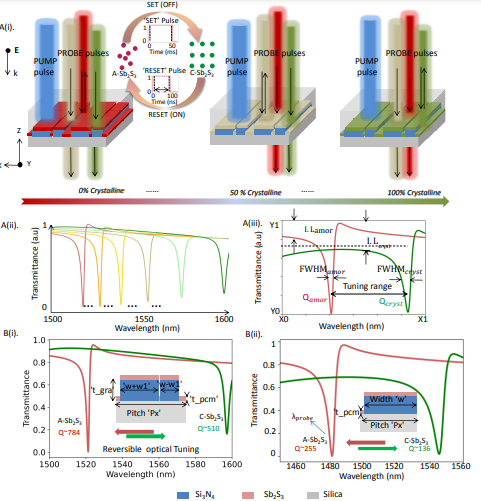
- Published in Departmental News, News, Research News
Enhancing Atmospheric Water Harvesting for Sustainable Water Solutions
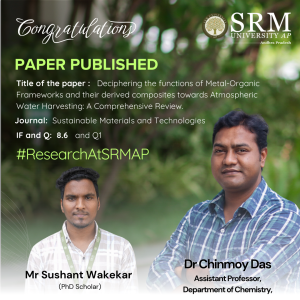 As water scarcity becomes an increasingly pressing issue, innovative solutions like atmospheric water harvesting (AWH) are being explored to provide sustainable access to fresh water. Dr Chinmoy Das, Assistant Professor from the Department of Chemistry and his research scholar Mr Sushant Wakekar have in their research paper titled, “Deciphering the functions of Metal-Organic Frameworks and their derived composites towards Atmospheric Water Harvesting: A comprehensive Review” analysed the crucial role of metal-organic frameworks (MOFs) and their composites in enhancing the efficiency of AWH systems.
As water scarcity becomes an increasingly pressing issue, innovative solutions like atmospheric water harvesting (AWH) are being explored to provide sustainable access to fresh water. Dr Chinmoy Das, Assistant Professor from the Department of Chemistry and his research scholar Mr Sushant Wakekar have in their research paper titled, “Deciphering the functions of Metal-Organic Frameworks and their derived composites towards Atmospheric Water Harvesting: A comprehensive Review” analysed the crucial role of metal-organic frameworks (MOFs) and their composites in enhancing the efficiency of AWH systems.
Abstract
To address water scarcity globally, recently atmospheric water harvesting (AWH) has emerged as an intriguing and sustainable solution. This comprehensive review critically investigates how diversity in metal-organic frameworks (MOFs) and their composite materials shapes the effectiveness and practicality of AWH technologies. These materials range from pristine MOFs to functionalized MOFs-based composites to attain the sophisticated hydrophilic behavior to perform as water harvesters. The multifaceted effects of MOFs and their composite materials on the kinetics of sorption and condensation, the feasibility of water uptake and release, the overall performance of the materials, the theoretical understanding of water uptake, and various instrumentation techniques have been demonstrated in this comprehensive review. It contributes to the ongoing discourse on sustainable water sourcing by emphasizing the pivotal role of materials diversity in shaping the future of AWH technologies.
Explanation of Research in layperson’s terms:
This review article explains how AWH technology, which captures water from the air, could provide sustainable solutions for water scarcity. We focus on advanced materials called MOFs and their ability to improve AWH efficiency. By analyzing different types of MOFs and MOF-based composites, we explore how they enhance water absorption and release, potentially making AWH more practical and effective for real-world use.
Practical/Social Implications of the Research:
This technology could have far-reaching social impacts by offering a reliable water source for communities in arid or remote areas, reducing reliance on traditional, often costly water sources, and strengthening resilience to climate change.
Future Research Plans:
To design and synthesis a material which can work with a minimum relative humidity (%RH) and design a suitable prototype for it.
Link to the Article
https://www.sciencedirect.com/science/article/pii/S2214993724003002
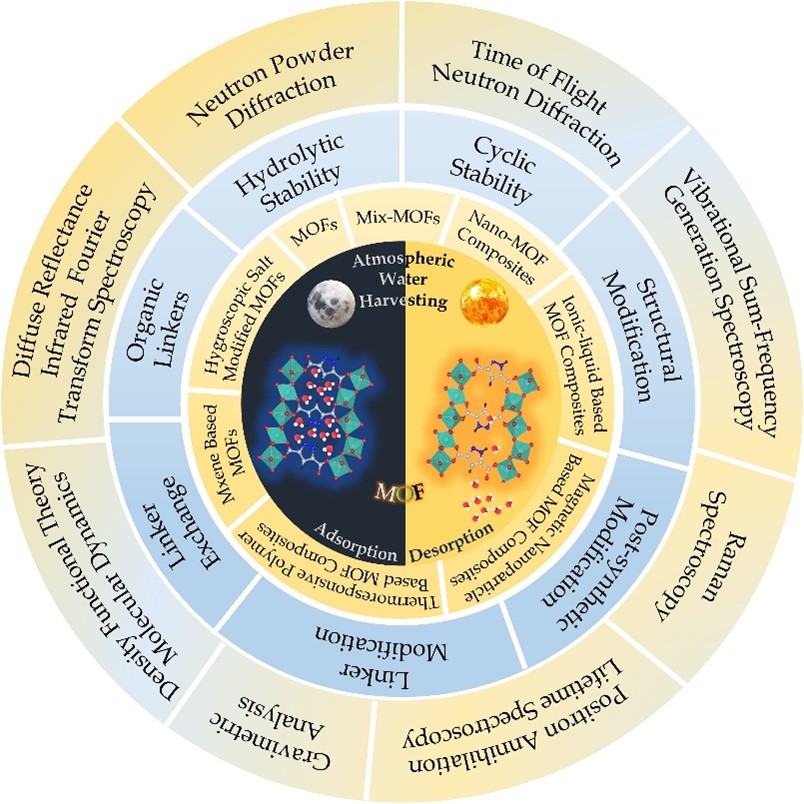
- Published in Chemistry-news, Departmental News, News, Research News
Understanding the Impact of Sundarbans Mangroves on Global Oceanic Carbon Budgets
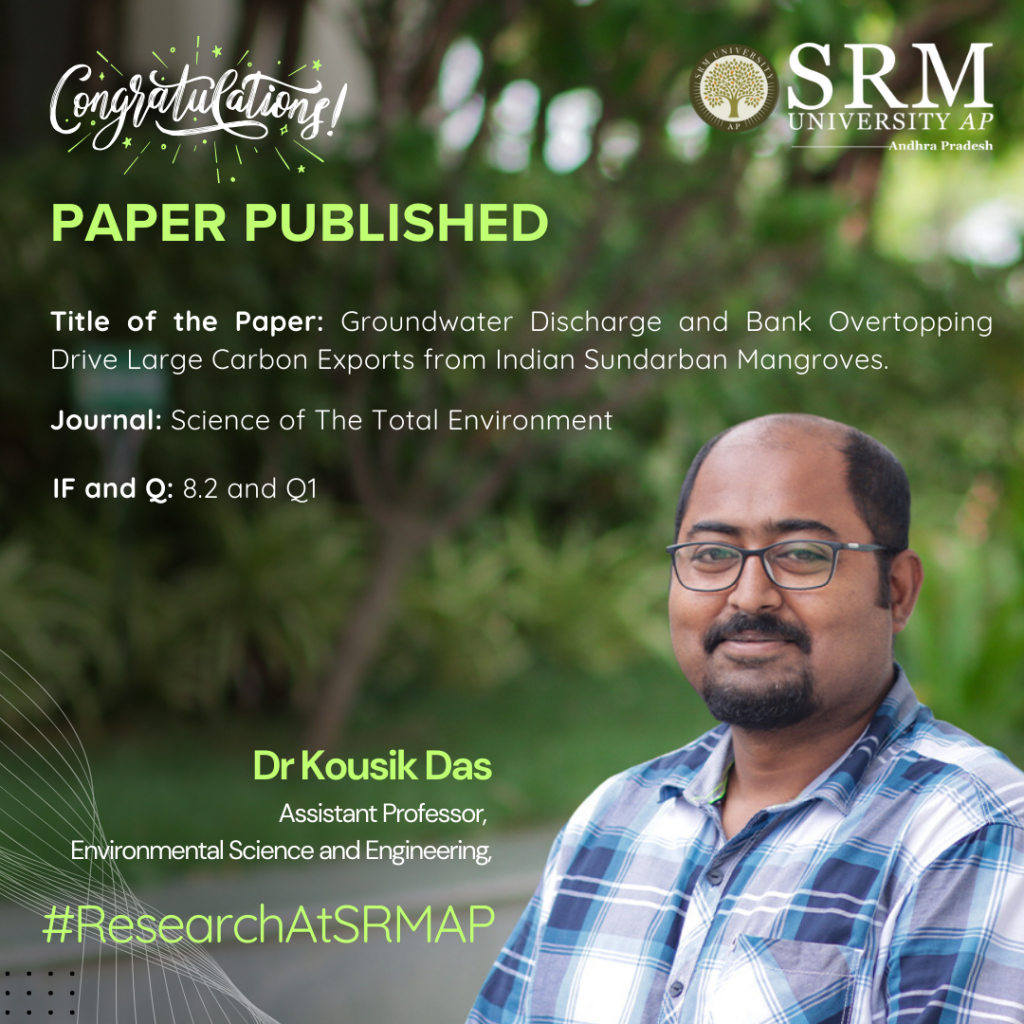
The Sundarbans represent the largest mangrove system on Earth, covering >10,000 km2. These mangroves can export a vast amount of aquatic carbon that can be potentially sequestered for millennia. Dr Kousik Das, Assistant Professor at the Department of Environmental Science and Engineering, collaborates with Southern Cross University, Australia and IIT Kharagpur to conduct breakthrough research to analyse and estimate the carbon flux between the Sunderbans and the Bay of Bengal. He has published a research paper titled “Groundwater discharge and bank overtopping drive large carbon exports from Indian Sundarban mangroves” in the Q1 journal Science of The Total Environment, having an impact factor of 8.2.
Abstract
We estimate porewater-driven carbon exchange between the Sundarbans and the Bay of Bengal using high-resolution time series and a radon groundwater mass balance approach spanning a neap-spring tidal cycle. Submarine groundwater discharge (SGD) increased from neap to spring tides by 352 % up to a maximum of 65.6 cm d−1 largely driven by creek bank overtopping after the mid-tide. Exports of dissolved organic and inorganic carbon and alkalinity doubled between neap and spring, likely due to the ‘first flush’ of older porewater in the mangrove flats. Groundwater discharge was a significant driver of the net carbon export, contributing up to 86.7 % of DIC and 74.0 % of alkalinity during the spring tide while contributing a lower proportion of DOC (4 %–23 %). If these results are representative of the Sundarbans more broadly, carbon fluxes from the Sundarbans would be more than an order of magnitude higher than some of the world’s largest rivers on an areal basis, highlighting the importance of Sundarbans mangroves to global oceanic carbon budgets.
Practical Implementation/Social Implications of the Research
This study shows the global importance of the Sundarbans mangrove system, with significant dissolved inorganic carbon and total alkalinity fluxes to the Bay of Bengal. It also shows that mangrove SGD is an important driver of dissolved inorganic carbon, dissolved inorganic carbon (DIC) and total alkalinity (TAlk) exports and that bank overtopping during mid and spring tides drives a ‘first flush’ of carbon from groundwater. When carbon fluxes from the study site were upscaled to the entire inundated area of the Sundarbans, DIC and TAlk exports were smaller than some of the world’s largest rivers, however when adjusted to the catchment size (assuming the Sundarbans mangrove catchment area is the extent of the mangroves; 10,200 km2), the areal carbon fluxes from the mangroves are more than an order of magnitude higher than these river systems
Dr Das aims to continue his research and further explore the large flux of carbon export due to tropical cyclones from the Indian Sundarbans to the Bay of Bengal.
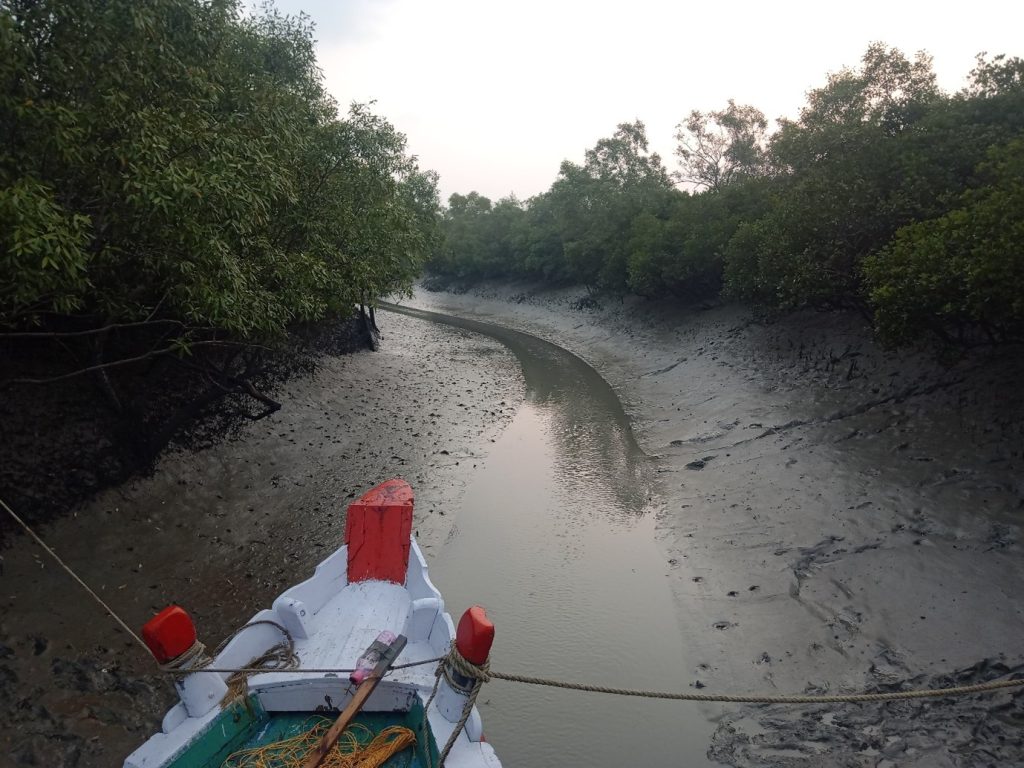
- Published in Departmental News, ENVS News, News, Research News
A Novel Method to Estimate Parameters in Complex Biochemical Systems
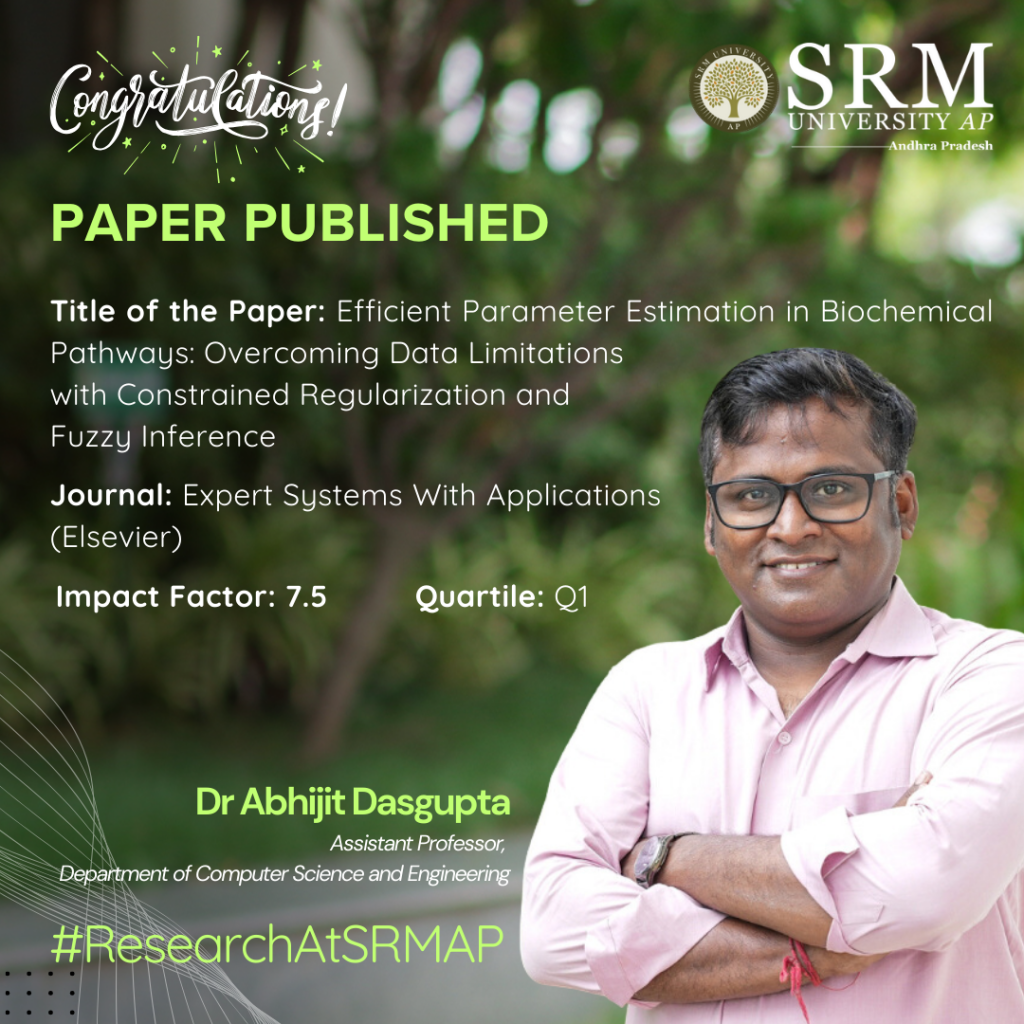
With the advent of cutting-edge technology, Dr Abhijit Dasgupta, Assistant Professor at the Department of Computer Science and Engineering, has conducted breakthrough research in understanding biochemical systems with limited data in hand. His research has been published as a paper titled “Efficient Parameter Estimation in Biochemical Pathways: Overcoming Data Limitations with Constrained Regularization and Fuzzy Inference” in the Elsevier journal Expert Systems With Applications, having an impact factor of 7.5.
Abstract
This study introduces a new method to estimate parameters in biochemical pathways without relying on experimental data. The method called the Constrained Regularized Fuzzy Inferred Extended Kalman Filter (CRFIEKF) uses fuzzy logic to estimate parameters based on known but imprecise relationships between molecules. To handle complex and unstable data, the method incorporates Tikhonov regularisation, improving accuracy and stability. CRFIEKF was tested on several pathways, including glycolysis and JAK/STAT signalling, and reliable results were obtained. This approach offers a useful tool for estimating parameters in complex biochemical systems, especially when experimental data is limited.
Explanation of the Research in Layperson’s Terms
This research is about finding a new way to predict how living cells work, especially when scientists don’t have enough data from experiments. Normally, to understand how cells function, scientists need to collect a lot of information over time, which can be costly, difficult, or even impossible.
To solve this, the researchers developed a new method that doesn’t need as much experimental data. Instead of relying on exact measurements, their method uses fuzzy logic, which is like making smart guesses based on patterns and relationships we know, even if we don’t have perfect information. They also used a technique to keep these guesses steady and reliable, even when the data is messy or incomplete.
They tested this method on different biological processes, such as how cells turn food into energy (a process called glycolysis) and how cells send signals using proteins (like in the JAK/STAT pathway). The method worked well and gave accurate results.
In simple terms, this research helps scientists predict how cells behave without needing a lot of expensive and hard-to-get data, making it easier to study the complex systems inside living organisms.
Practical Implementation/Social Implications of the Research
The practical implementation of this research lies in its ability to accurately predict how biological systems, such as cells, function without relying heavily on time-consuming and costly experimental data. This method can be applied in various fields, including drug development, personalised medicine, and agriculture, where understanding complex biological processes is crucial. For instance, pharmaceutical companies could use this technique to model how a drug will interact with different biological pathways, speeding up the drug discovery process. Similarly, it could help tailor medical treatments to individual patients by predicting how their unique biological makeup will respond to specific therapies.
The broader social impact of this research is significant. By reducing the need for extensive experimental data, this method can lower the cost and time required for scientific discoveries in healthcare and biotechnology. This could lead to faster development of new medicines, more affordable healthcare solutions, and personalised treatments that improve patient outcomes. In agriculture, this method can help optimise crop growth and resilience, contributing to food security. Overall, this research provides a pathway for more efficient and cost-effective advancements in biology, healthcare, and environmental sciences, ultimately benefiting society by improving health and sustainability.

Collaborations
1. St Jude Children’s Research Hospital, Memphis, USA
2. University of California, San Diego, USA
3. Columbia University, New York, USA
4. Nantes Université, France
5. University of North Carolina at Chapel Hill, USA
6. Institute of Himalayan Bioresource Technology, Palampur, India
7. Indian Statistical Institute, Kolkata, India
8. Aliah University, Kolkata, India
9. Michelin India Private Limited, Pune, India
10. Gitam University, Bangalore, India
Future Research Plans
Building on the foundation laid by this research, the next steps will involve expanding its applications to more complex biological systems and personalised medicine. The following outlines a future roadmap:
1. From Time-Course Data to Pathway Enrichment and Single-Cell Modeling:
The current method, which estimates parameters without relying on time-course data, can be adapted to use time-course data when available. Time-course data captures how biological processes change over time, offering valuable insights. By integrating this data, we can refine the parameter estimation and achieve a more precise pathway enrichment analysis. This approach can be particularly beneficial in single-cell studies, where understanding the variability in cellular responses within complex diseases like cancer, diabetes, or neurodegenerative disorders is crucial. Modelling these pathways at the single-cell level will enable us to capture heterogeneity within tissues and improve disease understanding.
2. Simulating Pathways to Identify Drug Targets:
Once the pathways are enriched and modelled, we can simulate these biological networks to predict how different interventions—such as drugs—might influence the system. This simulation can help identify potential drug targets, particularly those that are critical in disease progression. For instance, by manipulating the modelled pathways, we can observe how specific proteins or molecules influence the disease state, providing insights into where a drug could be most effective.
3. Predicting Drug Side Effects:
After identifying potential drug targets, the next step is to predict the side effects of these interventions. The same model can simulate unintended consequences by analysing how modifying a target impacts other connected pathways. This simulation can provide early warnings about potential side effects, reducing the risk during later stages of drug development. Understanding these off-target effects at an early stage will be crucial for designing safer drugs.
4. Predicting Drug Molecules Using Generative Adversarial Networks (GANs):
Incorporating machine learning, particularly Generative Adversarial Networks (GANs), can take this research to the next level. GANs can be trained to generate new drug molecules by learning from existing drug databases. By feeding the pathway model’s identified targets into the GAN, we can generate candidate drug molecules that are predicted to interact with these targets effectively. This approach can significantly speed up the drug discovery process by automating the design of new drug candidates tailored to specific biological pathways.

5. Integration with Omics Data for Personalized Medicine:
The future of personalised medicine relies on integrating various layers of biological data—such as genomics, transcriptomics, proteomics, and metabolomics—into a cohesive model. By integrating pathway data with these other “omics” layers, this research will facilitate a more comprehensive understanding of individual patient biology. This integration allows for tailored treatment strategies, making personalised medicine more achievable. For instance, based on an individual’s genetic makeup and biological pathways, we can predict how they will respond to specific drugs and design personalised therapies with minimal side effects.
6. Pathway-Based Drug Design and Validation:
Once potential drug molecules are identified using GANs, they can be simulated within the enriched pathways to test their efficacy in silico. These simulations will allow researchers to understand how the drug interacts with the target pathway and its downstream effects. If the simulation shows promising results, the drug candidates can be prioritised for lab testing and clinical trials. This systematic approach, from modelling to simulation, could drastically reduce the time and cost associated with traditional drug discovery processes.
Summary
This plan transforms the current research from a powerful parameter estimation technique into a comprehensive framework for personalized medicine and drug discovery. By expanding to time-course data, single-cell modeling, pathway simulation, and integrating cutting-edge AI techniques like GANs, we can predict drug molecules tailored to individual biological systems. This personalized approach not only streamlines drug discovery but also enhances the safety and effectiveness of treatments, paving the way for more efficient and precise medical interventions.
- Published in CSE NEWS, Departmental News, News, Research News


